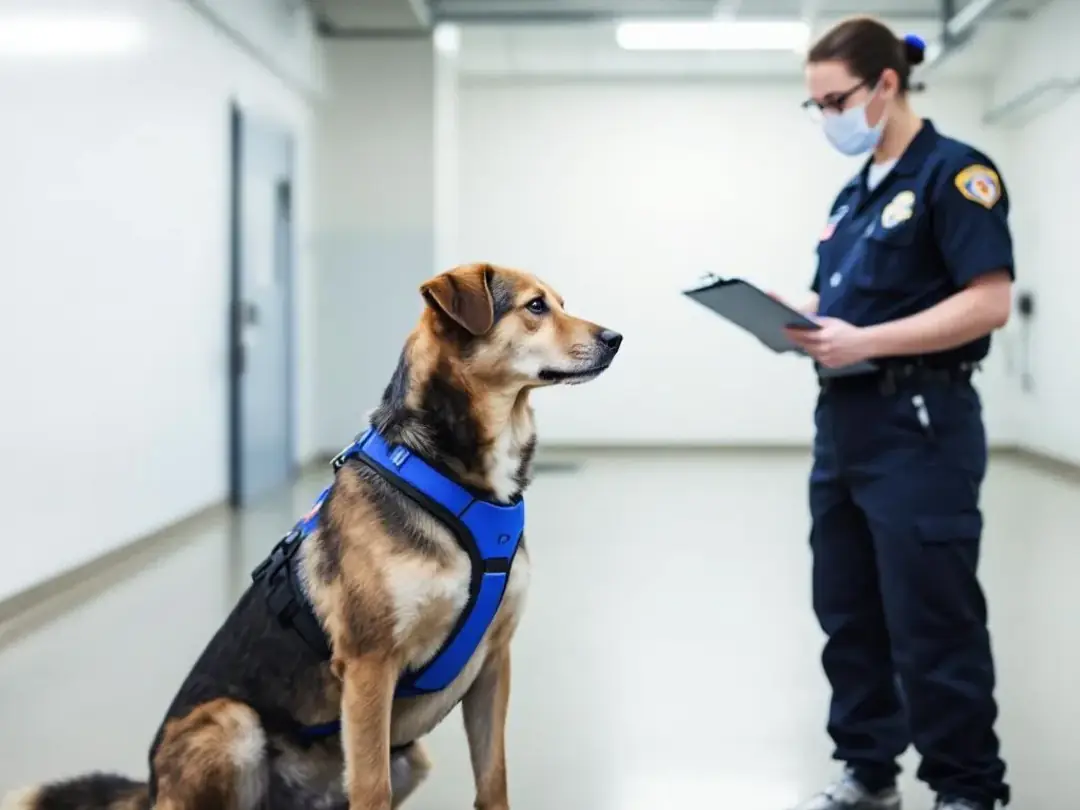Key Takeaways
-
Temperament testing evaluates a dog's innate reactions to strangers, auditory stimuli, visual cues, and unusual situations through standardized protocols
-
The American Temperament Test Society (ATTS) test consists of ten subtests taking 8-12 minutes, requiring dogs to be at least 18 months old
-
Testing helps breeders select breeding stock, daycare facilities group dogs safely, and owners understand their pet's behavioral tendencies
-
Professional evaluation measures stability, shyness, aggressiveness, friendliness, and protective instincts in controlled environments
-
Results guide training strategies, socialization programs, and help match dogs with appropriate living situations
What is Temperament Testing for Dogs
Temperament testing systematically evaluates a dog's natural behavioral responses to controlled stimuli and situations. Rather than assessing learned behaviors like sit or stay, these tests measure innate traits that determine how dogs respond when faced with various situations they haven't specifically been trained for. Temperament testing helps us understand how dogs react to various situations and interactions, providing valuable insight into their natural tendencies.
The fundamental difference between temperament and behavior lies in origin and malleability. Temperament reflects genetic predisposition-the foundation that influences whether your dog naturally approaches or avoids new experiences. Behavior, conversely, represents learned responses shaped by training, experience, and environment. While you can teach a fearful dog to tolerate strangers through gradual exposure, their underlying temperament may always lean toward caution.
Professional temperament testing serves multiple purposes across different contexts. Breeders use results to select dogs with stable temperaments for their breeding programs, ensuring puppies inherit sound psychological foundations. Dog daycare facilities rely on temperament assessments to group dogs safely, recognizing that a dog's protective instincts or reaction to other dogs directly impacts group dynamics. Temperament testing also assesses a dog's protective instincts, which can influence how they interact with other dogs and people in a group setting. Individual owners benefit from understanding whether their dog's temperament suits their lifestyle, from apartment living to participation in dog shows. Temperament testing helps pet owners understand how their pets are likely to behave in different situations, aiding in better management and training.
The evaluation process focuses on five core areas: stability under pressure, sociability with strangers, fear responses and recovery capabilities, protective instincts when challenged, and general curiosity toward new experiences. Temperament testing evaluates a dog's temperament and ability to distinguish between non-threatening and threatening situations, which is crucial for safety and management. A dog displaying strong avoidance during testing reveals, different management needs than one showing confident investigation of novel stimuli.
Preparing for Temperament Testing and Scoring the Dog's Reaction to Each Test
Proper preparation is key to getting the most accurate results from a temperament test. Whether you're a pet parent, breeder, or shelter staff member, understanding temperament and how your dog reacts to various stimuli will help you set your dog up for success. Temperament tests are designed to evaluate a dog's reaction to strangers, other dogs, unusual footing, and a range of auditory, visual, and tactile stimuli. These tests provide valuable insight into your dog's active social skills, protective instincts, and recovery response, helping determine suitability for dog sports, dog shows, breeding, or as a family pet.
To prepare for a temperament test, start with early socialization. Expose your dog to a variety of environments, people, and other dogs of different breeds, ages, and sizes. This helps your dog develop confidence and reduces the risk of aggressive behavior or strong avoidance when faced with new situations. Socialization should include positive experiences with strangers, brief conversations with new people, and supervised play with more dogs to build your dog's ability to adapt to various situations.
On the day of the test, ensure your dog is comfortable walking on a leash and accustomed to encountering different surfaces, such as wire or plastic footing. The test takes about 8-12 minutes and consists of ten subtests, each designed to assess your dog's reaction to specific challenges. For example, your dog's response to the sound of a metal bucket filled with rocks or the sudden appearance of a hidden assistant will be observed to evaluate auditory and visual alertness. Tactile stimuli, like walking over unusual footing, further test your dog's adaptability and confidence.
Breeders and owners benefit from temperament testing by gaining a deeper understanding of their dog's personality and behavior. The results can help determine if a dog is well-suited for dog shows, breeding programs, or as a companion animal. Shelter staff also use these tests to match dogs with the right families and environments, ensuring a better fit and long-term success.
It's important to remember that temperament tests should always be conducted by trained evaluators who can accurately interpret the results in the context of the dog's breed, age, and individual characteristics. By preparing your dog through early socialization and exposure to various stimuli, you'll help ensure the test provides a true picture of your dog's temperament. This preparation not only improves the accuracy of the evaluation but also strengthens the bond between you and your dog, giving you valuable insight into their unique needs and abilities.


The American Temperament Test Society (ATTS) Protocol
The ATTS has established the gold standard for canine temperament evaluation through a standardized protocol that takes 8-12 minutes to complete. This test takes place in a controlled environment designed to simulate real-world encounters while maintaining consistent conditions across all evaluations.
Dogs must be at least 18 months old to participate in ATTS testing, ensuring skeletal and neurological maturity. During the entire length of the evaluation, dogs remain on a loose six-foot leash, allowing natural movement while maintaining handler control. The testing environment features various surfaces including wire footing and plastic footing to assess tactile responses, along with designated markers that guide the progression through each subtest.
The American Kennel Club recognizes ATTS results, adding credibility to the certification process. Testing requires qualified professionals who understand both canine behavior and safety protocols. Each dog is evaluated individually-only the dog being tested enters the evaluation area, preventing influence from other dogs or pack dynamics.
The 10 Subtests Explained
The ATTS protocol consists of ten subtests, each designed to evaluate specific aspects of temperament:
Subtests 1-2: Stranger Interaction These initial tests assess the dog's response to neutral and friendly human approaches. A stranger approaches in a non-threatening manner, and the dog's alertness is specifically evaluated as the stranger gets closer, observing the dog's social interest. The stranger then engages in a brief conversation with the handler. In the second subtest, the stranger shakes hands with the handler, and the dog's reaction to this gesture is carefully observed to assess social behavior during physical contact between humans.
Subtests 3-4: Auditory Stimuli Sound sensitivity testing begins with a hidden assistant creating noise with a metal bucket filled with rocks, followed by three gunshot sounds. These auditory stimuli reveal how dogs process sudden, loud noises, and the dog's recovery response after startling sounds is carefully assessed to determine how well the dog regains composure and focus.
Subtests 5: Visual Stimulus A sudden umbrella opening provides visual stimulus testing, evaluating the dog's reaction to unexpected visual changes and their ability to process and recover from surprise visual events.
Subtests 6-7: Tactile Challenges Dogs navigate unusual footing surfaces, walking across plastic strips and through a wire pen section. These tests assess confidence on unstable or unfamiliar surfaces and the dog's ability to adapt to tactile challenges.
Subtests 8-10: Threat Assessment The final three subtests escalate in intensity, featuring an unusual-looking stranger, an advancing threat scenario, and an aggressive approach. These evaluate the dog's protective instincts, ability to distinguish real threats from harmless situations, and response to direct challenges.
In some testing environments, toys and other enrichment items may be used to help assess motivation or provide positive reinforcement during or after subtests.


Types of Dog Temperaments Including Aggressive Behavior
Understanding temperament requires recognizing that breed-specific traits influence expected responses. The ATTS evaluates dogs against their dog's breed standards rather than applying universal criteria. A protective breed like a Rottweiler should respond differently to threats than a companion breed like a Golden Retriever. When grouping dogs for daycare, energetic dogs may require special consideration, as housing multiple active or lively dogs together can lead to disruptions if their temperaments are not managed appropriately.
Emotional Stability Stable dogs maintain composure under pressure, recovering quickly from startling stimuli. They show appropriate breed-specific responses without overreacting or shutting down completely. Unstable temperaments manifest as extreme reactions-either excessive fear or inappropriate aggression that doesn't match the situation's actual threat level.
Social Behavior Spectrum Dogs range from naturally shy to boldly outgoing in their approach to strangers. Shy dogs may initially withdraw but should show curiosity and gradual approach with encouragement. Overly social dogs might lack appropriate caution, while well-balanced dogs assess situations before deciding on their response level. Temperament testing also evaluates a dog's response to an unfamiliar person, helping assess social skills and protective instincts during interactions with strangers.
Fear Response and Recovery Healthy fear responses involve brief startle reactions followed by investigation or recovery. Dogs with poor recovery remain stressed long after stimuli disappear, while fearless dogs may lack appropriate caution in genuinely dangerous situations. The dog's recovery response often proves more important than their initial reaction.
Protective Instincts and Aggression Appropriate protective behavior emerges only when genuine threats appear, not during routine interactions. Dogs showing unprovoked aggression or attacking in non threatening situations demonstrate temperament problems. Conversely, dogs that cannot distinguish between real threats and harmless encounters may lack necessary protective instincts for their intended roles.


Temperament Testing for Different Purposes
Breeding Program Selection Responsible breeders use temperament testing to identify dogs with stable, breed-appropriate temperaments for reproduction. Testing reveals genetic tendencies that puppies may inherit, helping breeders make informed decisions about which dogs should contribute to future generations. Dogs displaying excellent temperament scores often become foundation animals for breeding programs focused on producing mentally sound offspring. Owners and breeders who are interested in obtaining official recognition for their dog's temperament can pursue certifications or titles through organizations like the ATTS.
Dog Daycare Safety and Grouping Daycare facilities rely on temperament assessments to create safe, compatible dog groups. Understanding each dog's reaction to other dogs, stress tolerance, and social preferences allows staff to prevent conflicts before they occur. Dogs with strong protective instincts require different management than those with high social drive or fear-based responses.
Adoption Matching and Placement Shelter staff use temperament testing to match dogs with appropriate families and living situations. Temperament testing is also used to assess pups, helping to match them with suitable homes based on their innate traits. A dog showing high energy and confidence during testing might thrive with an active family but struggle in a quiet apartment. Conversely, dogs displaying shyness or fear responses often succeed with patient owners willing to invest in gradual socialization.
Training Program Customization Professional trainers use temperament results to design individualized training approaches. Dogs with high food motivation respond differently to reward-based training than those driven by toy play or social interaction. Understanding temperament helps trainers select appropriate methods and realistic goals for each dog's capability.
Therapy and Service Dog Evaluation Organizations selecting therapy or service dog candidates rely heavily on temperament testing to identify dogs with the stability and specific traits needed for these demanding roles. These dogs must demonstrate exceptional emotional stability, appropriate social responses, and the ability to maintain focus despite environmental distractions.
Puppy Temperament Testing Considerations
Puppy testing requires modified protocols that account for developmental stages and limited life experience. Young puppies lack the neurological maturity and exposure necessary for adult testing protocols, making standard ATTS testing inappropriate for dogs under 18 months.
Professional puppy evaluations focus on basic temperament indicators: response to handling, reaction to new environments, interest in human interaction, and recovery from mild stress. These early assessments provide general guidance but cannot predict adult temperament with complete accuracy.
Early socialization significantly impacts puppy test results, sometimes masking underlying temperament traits or creating temporary behavioral patterns that change as dogs mature. Responsible evaluation considers both genetic predisposition and environmental influence when interpreting puppy temperament results.
Safety Protocols and Professional Standards
Adult supervision remains mandatory during all temperament testing, with qualified professionals managing both the testing process and safety protocols. Testing stops immediately when dogs show signs of excessive stress, resistance, or inappropriate aggression that could endanger participants.
Dogs in heat or intact males in the presence of females in heat cannot participate in group testing situations due to the hormonal influences that can alter normal temperament responses. These conditions create artificial stress and competitive behaviors that don't reflect the dog's true temperament.
Essential equipment includes properly fitted collars, standard six-foot leashes, and all testing props (metal bucket, umbrella, surface materials). Each item must be maintained in good condition to ensure consistent testing conditions across all evaluations.
Qualified professionals understand canine body language, stress signals, and de-escalation techniques. They recognize the difference between appropriate breed responses and concerning behavioral patterns, ensuring accurate assessment while maintaining safety for all participants.
Implementing Test Results in Practice
Creating Temperament-Based Dog Groupings Daycare facilities use test results to establish compatible playgroups based on temperament compatibility rather than just size or energy level. Dogs with similar social styles and stress tolerance levels often play together more successfully than random groupings.
Developing Individualized Training Plans Test results guide training method selection and goal-setting. Dogs showing high environmental sensitivity require gradual exposure protocols, while confident dogs may progress more quickly through challenging training scenarios. Understanding each dog's temperament allows trainers to work with natural tendencies rather than against them.
Managing Temperament-Specific Challenges Dogs with protective temperaments need clear leadership and appropriate outlets for their guarding instincts. Shy dogs benefit from confidence-building exercises and gradual exposure programs. High-energy dogs require sufficient physical and mental stimulation to prevent behavioral problems.
Documentation and Record-Keeping Proper documentation includes test scores, specific behavioral observations, and recommendations for ongoing management. This information helps future handlers, veterinarians, and trainers understand the dog's needs and potential challenges.
Staff Training on Temperament-Based Handling Professional facilities train staff to recognize temperament types and adjust their handling accordingly. Understanding whether a dog's behavior stems from fear, confidence, or protective instincts helps staff respond appropriately to various situations.
FAQ
How accurate are temperament tests in predicting future behavior?
Temperament tests provide valuable insights into a dog's innate tendencies, but they represent behavior at a specific moment in time. While they're excellent predictors of general behavioral patterns, environmental factors, training, and life experiences continue to influence a dog's behavior throughout their life. The test results should be viewed as one component of understanding your dog, not a definitive prediction of all future responses.
Can a dog retake the ATTS temperament test if they fail?
Yes, dogs can retake the ATTS test after additional training and socialization. Many dogs benefit from exposure to the test elements through gradual desensitization and may perform better on subsequent attempts once they're more comfortable with the various stimuli. However, it's important to work with a qualified behavior consultant to address the specific issues that led to the initial failure.
Are certain dog breeds more likely to pass temperament tests?
While breed tendencies exist, individual dogs within breeds can vary significantly. The ATTS evaluates each dog against their breed's expected temperament standards rather than using a one-size-fits-all approach, recognizing that protective breeds should respond differently than companion breeds. Success rates vary more by individual dog training and socialization than by breed alone.
What happens if my dog shows aggressive behavior during testing?
Testing is immediately stopped if a dog displays inappropriate aggression or becomes overly stressed. The safety of all participants is paramount, and qualified testers are trained to recognize warning signs and de-escalate situations before they become dangerous. The aggressive manner of response is carefully documented to help determine appropriate next steps for training or management.
How long should I wait between temperament testing sessions?
If a dog needs retesting, most professionals recommend waiting at least 6-8 weeks to allow time for training and behavior modification work. This interval also helps ensure the dog isn't simply memorizing the test sequence rather than demonstrating genuine temperament improvements. During this time, focus on addressing the specific areas where your dog struggled during the initial evaluation.






